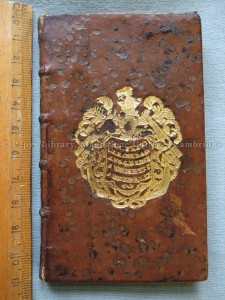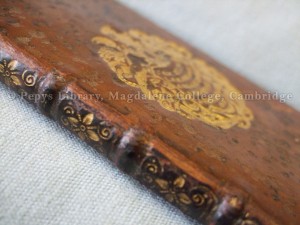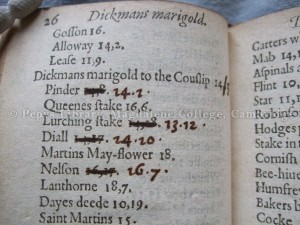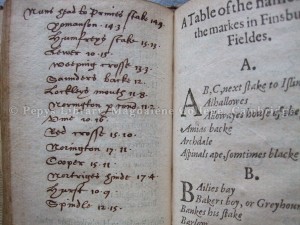“The mighte of the realme of Englande standyth upon archers.”
One of the smallest books in the Pepys Library is Ayme for Finsburie archers. Or an Alphabetical Table of the names of euerie Marke within the same fields, with their true distances both by the Map and dimensuration by the line. Published for the ease of the skilfull, and behoofe of the yong beginners in the famous exercise of Archerie, by E.B. and I.I. Corrected and amended of diuerse errours with addition of those Markes which wanted in the former printed Bookes. Imprinted at London by R.F and are to be sold at the signe of the Frier in Grubstreet by F. Sergeant, 1601.
 Ayme for Finsburie archers is a historical record and guide detailing the marks and longbow archery targets set out in Finsbury Fields, 11 acres of ground in North London which extended from the City wall to Islington, Hoxton and Shoreditch. The book was first published in 1590 and then later reprinted in 1594 and 1601. In 1628 it was ‘newly gathered and amended’ by James Partridge, printed by G. Miller and sold in St. Paul’s Churchyard.
Ayme for Finsburie archers is a historical record and guide detailing the marks and longbow archery targets set out in Finsbury Fields, 11 acres of ground in North London which extended from the City wall to Islington, Hoxton and Shoreditch. The book was first published in 1590 and then later reprinted in 1594 and 1601. In 1628 it was ‘newly gathered and amended’ by James Partridge, printed by G. Miller and sold in St. Paul’s Churchyard.
The practice of archery was vital to military defence and in the 15th century, Sir John Fortescue (c. 1394-c.1480) claimed “The mighte of the realme of Englande standyth upon archers.”1. The Civic Ordinance of 1478 proclaimed that the fields of London were to be kept open and free from obstacles for the practise of archery by both citizens and the military and longbow shooting began in Finsbury Fields around 1498. Henry VIII was a keen archer from an early age and he helped to promote the practice of archery. In the third year of his reign in 1511 he introduced a statute which commanded that every father should provide his son with a bow and two arrows at the age of seven. He also prohibited any archery practise at a distance of less than 220 yards. In addition, Henry VIII later commissioned classical scholar Roger Ascham (1515-1568), tutor to Princess Elizabeth, to write Toxophilus to praise the practice of shooting with the longbow instead of the new hand-gun in a platonic dialogue between Toxophilus (“A Lover of the Bow”) and Philologus (“A Lover of Learning”). It was published in 1545 and was the first academic work to be written in English rather than Latin or Greek.
 Ayme for Finsburie archers was published 56 years later and provides a practical guide to the many ‘stakes’ or marks that were erected in Finsbury Fields for shooting with the longbow at great distances, a series to be shot at in turn from left to right. The longest distance between the marks was 19 score, or 380 yards and the shortest distance was 9 score or 180 yards. The marks were wooden posts standing 3-4 feet high often bearing a crest or emblem for identification and commonly named after the person who created them. Many wooden posts remained permanently in place however stone pillars were later established by the Honourable Artillery Company to replace the decaying wooden markers. As a sport, scoring was decided by the closest arrow to the mark and the winning archer would be able to choose the next target. Ayme for Finsburie archers records the distances in scores and yards for every mark and assisted archers in their practise. The book was sold on Grub Street (now Milton Street), which at the time was inhabited by bowyers (longbow makers) and fletchers (arrow makers) and led to the open fields.
Ayme for Finsburie archers was published 56 years later and provides a practical guide to the many ‘stakes’ or marks that were erected in Finsbury Fields for shooting with the longbow at great distances, a series to be shot at in turn from left to right. The longest distance between the marks was 19 score, or 380 yards and the shortest distance was 9 score or 180 yards. The marks were wooden posts standing 3-4 feet high often bearing a crest or emblem for identification and commonly named after the person who created them. Many wooden posts remained permanently in place however stone pillars were later established by the Honourable Artillery Company to replace the decaying wooden markers. As a sport, scoring was decided by the closest arrow to the mark and the winning archer would be able to choose the next target. Ayme for Finsburie archers records the distances in scores and yards for every mark and assisted archers in their practise. The book was sold on Grub Street (now Milton Street), which at the time was inhabited by bowyers (longbow makers) and fletchers (arrow makers) and led to the open fields.
The introduction of firearms in England led to the steady decline of the longbow as a military weapon; however archery was still practised as a sport. As a result, fields that were once used for archery were gradually neglected, and over time they were eventually built upon and developed. Twenty-four marks were recorded to be still standing in 1737, 4 years after Pepys’ death.
In his diary entry on the 12th of May 1667, Pepys refers fondly to practising archery as a boy:
“and so my wife and I away and by coach to Islington, it being a fine day, and thence to Sir G. Whitmore’s house, where we light and walked over the fields to Kingsland and back again, a walk I think I have not taken these twenty years but puts me in mind of my boy’s time, when I boarded at Kingsland and used to shoot with my bow and arrows in these fields.” 2
Ayme for Finsburie archers is a rare copy of the 1601 printing and it is handsomely bound in mottled calf bearing Pepys’ armorial stamps and bookplates. It also has gold tooling on the spine and fore-edge with intricate blind tooling visible on the inside front and back boards. This suggests that, although Pepys does not refer to practising archery as an adult in his diary, Ayme for Finsburie archers was an important book to him.
Furthermore, the book contains several annotations and amendments which suggest it was once used in a practical manner. The book was published before Pepys was born in 1633 and therefore it is quite possible that the book was already annotated by the time it came into Pepys’ possession. Unfortunately the annotator’s hand remains unidentified but nevertheless it provides us with an intriguing and unique insight into the historical practice of longbow archery.
By Sophie Connor
Bibliographical notes:
- Hargrove, E. Anecdotes of archery; from the earliest ages to the year 1791 : Including an account of the most famous archers of ancient and modern times; with some curious particulars in the life of Robert Fitz-Ooth Earl of Huntington, vulgarly called Robin Hood. The present state of archery, with the different societies in Great Britain, particularly those of Yorkshire, Lancashire, and Durham. York : Printed for E. Hargrove, bookseller, Knaresbro’; and sold by all the booksellers of York, Leeds, and Ripon, 1792.
- Pepys, Samuel (edited by Latham, R. and Matthews, W.). The Diary of Samuel Pepys. Volume VIII, 1667. London : G. Bell and Sons Ltd, 1974.
References:
Nelson, J. The history and antiquities of the Parish of Islington in the county of Middlesex, including biographical sketches of the most eminent and remarkable inhabitants, with some account of several objects of interest in the adjoining parishes. Third edition. London: Printed and published by T. Lester, 14 Finsbury Place, Finsbury Square, and sold by all booksellers, 1829.
Partridge, James. (edited by Cooper, M.R.). Ayme for Finsburie archers. Royal Leamington Spa : W. C. Books, 1998
Wheatley, Henry B. London past and present: its history, associations, and traditions. London : Murray, 1891.
Related links:
The Worshipful Company of Bowyers http://www.bowyers.com/bowyery_finsburyMarks.php



